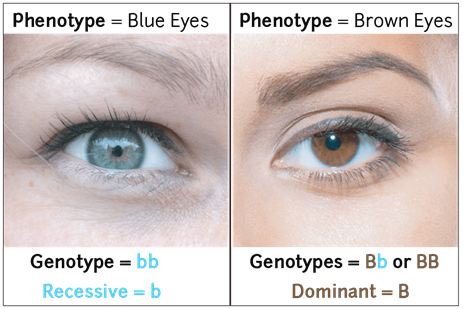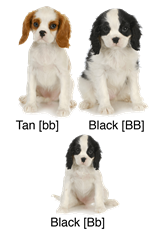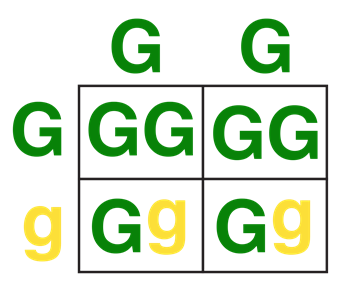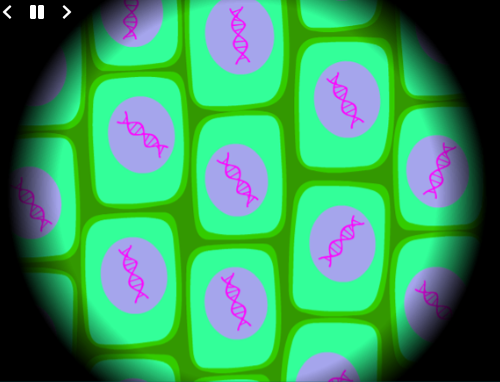Genetics
Figure BrainPOP
(username: jcesc / password: qfaf9361)
Your
genes are the instructions for making you. They help make you unique—similar to
all life on Earth!
Inside
the cells of every living thing are molecules of DNA. Hidden within DNA's
structure is a universal language: the genetic code.
This
simple but incredibly versatile code spells out genes for various traits.
Humans have been hacking into this code for thousands of years.
At
first, they did it by breeding plants and animals with useful traits, a process
called artificial selection. Genetic engineering technology makes it possible
to edit the code directly.
Click
"the image" to find out how genes affect our lives!
Genetics
So far, you know what DNA is and does in the
body. Now you will learn more about what DNA has to do with your appearance.
In your science
journal,
answer these questions.
1. Do you know how DNA is
passed from parents to offspring?
2. How do you think cells
determine which genes offspring get?
3. How are you similar to
your parents?
4. Can you think of
some traits that were passed down from your biological parents to
you? If so, what are they? If unsure, name some traits you think would be
passed down from parents to children.
Genetics is the science of genes and heredity.
Our bodies are made up of tiny, microscopic cells. Each cell has a nucleus that
contains 46 chromosomes. Each chromosome has hundreds to thousands of genes
that describe everything about you! Your hair color, height, eye color,
allergies, and overall health are already decided for you and encoded in your
genes! This special code is referred to as the genetic code. Heredity explains
how these traits or characteristics are passed from parents to offspring
(children). Let's explore more about how this works!
Let's Practice
Inheritance
Your genes make you unique. Everyone has genes
for eyes, ears, skin, bones, fingers, and toes. The combination of the genes
you get from your biological parents gives you a unique appearance, including
eye color, hair color, skin color, and nose and face shape.

Gene Alleles
You have learned that DNA is wound into chromosomes.
Each chromosome has a gene made from a specific section of DNA for a specific
trait. You can see in the image the small sections on each chromosome that
determine the specific trait.
All humans have 23 pairs of chromosomes. One
half of the pair comes from your biological mom and the other half from your
biological dad. Each chromosome has a copy of the same gene, but there are two
versions. The different versions of the same gene are called alleles.
Each biological parent donates one allele for each gene to an offspring.
There are two types of alleles:
- Dominant alleles show their effect even if the
other allele is different
- Recessive alleles show their effect only if the
other allele is the same recessive allele
For example, if you get dominant brown eye
color alleles from your biological parents, you will have brown eyes. You will
also have brown eyes if you get one dominant brown eye color allele from your
biological mother and one recessive blue eye color allele from your biological
father. But if you receive both parents' recessive blue eye color alleles, you
will have blue eyes.
Alleles are usually noted by letters of the
alphabet; recessive alleles are lowercase letters, and dominant alleles are the
capital versions of the same letters. For example, the allele for blue eyes (a
recessive trait) might be represented by "b," while the allele for
brown eyes (a dominant trait) might be "B."
Below is an image of a chart showing options of
a child's genes based on whether the parents have blue or brown eyes.

Genotype chart
The two alleles describing a single trait of an
organism are called its genotype. For instance, a brown-eyed
person can have a Bb or a BB genotype, while a blue-eyed person has a bb
genotype.
There are two ways to describe genotypes:
·
Homozygous: the two alleles are the same, either dominant
or recessive
·
Heterozygous: the two alleles are different, one dominant
and one recessive
You cannot easily see people's alleles, so it
is hard to know their genotypes. A brown-eyed person could have a genotype of
BB or Bb.
The physical expression of a genotype is called
a phenotype.
You can often tell a person's phenotype just by looking. It is easy to see that
a person has brown or blue eyes.
Below is an image of two eyes, one blue and one
brown, with differing genotypes.

Eye Color
You might wonder how there can be more than two
eye colors. Instead of just blue or brown eyes, people can have green, hazel,
grey, or even amber eyes. How can this happen with only two alleles?
The answer is that more than one gene decides
eye color. Many genes are involved in traits with various phenotypes, such as
hair color, skin color, and height.
Let's Practice
You've learned how traits are passed down from
biological parents to offspring. So far, you have seen how simple dominance
works when a dominant allele completely masks a recessive allele.
In your science
journal,
answer these questions.
1.
Do you think all traits happen because of simple dominance? Why
or why not?
2.
Can you think of a trait that has different phenotypes?

Simple Dominance
Who
introduced the world to genetics?
Almost 200 years ago, a monk named Gregor
Mendel studied pea plants to learn how heredity works. Pea
plants, like people, have chromosomes and produce offspring with two parents
through sexual reproduction.

Greg Mendel
Gregor Mendel started the science of heredity,
or inheritance, and helped explain why offspring from sexual
reproduction sometimes look like their parents and sometimes do not.
Mendel's work with pea plants helped people
understand how traits are inherited. But other plants and most animals are more
complicated than pea plants.
Flower petal color is an example of a trait
with many different phenotypes. In the picture, neither the red allele (CR)
nor the white color allele (CW) is dominant. When the two alleles
mix, they make a new phenotype—pink (CRCW). This is
incomplete dominance.

Incomplete Dominance
Codominance works similarly. As with incomplete
dominance, there is no dominant phenotype. Instead, both traits show up
when codominant alleles mix. In the picture, a roan cow (CRCW)
has both red and white hair, getting its red hair from one parent (CRCR)
and its white hair from the other parent (CWCW).
Can you tell the difference between simple
dominance, incomplete dominance, and codominance?

Codominance
Punnett
Squares
A Punnett square is a tool biologists use to
see how parents pass different traits to offspring.
You can predict the traits of pea offspring by
making Punnett squares of the alleles of parent plants.
Remember:
- A
capital letter means a dominant trait, and a lowercase letter means a recessive
trait
- A
capital letter (dominant trait) should be written before a lowercase
letter (recessive trait)
- A
dominant trait shows up when it is mixed with either a dominant or a
recessive allele
- A
recessive trait only shows up when it is mixed with another recessive
allele
Science Journal
Look at the example of a Punnett square that
crosses a green plant with two green color alleles (GG) and a green plant with
both green and yellow color alleles (Gg).

In your science journal, answer the questions:
1.
How many of the new plants will be GG?
2.
How many of the new plants will be Gg?
3.
How many of the new plants will be green?
Let's Practice
